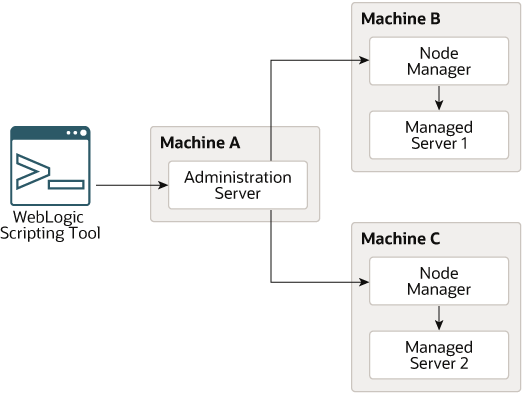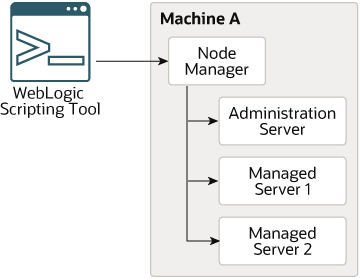3 Managing the Server Life Cycle
For more information about the server life cycle, see Understanding Server Life Cycle in Administering Server Startup and Shutdown for Oracle WebLogic Server.
For information on other techniques for starting and stopping server instances, see Starting and Stopping Servers in Administering Server Startup and Shutdown for Oracle WebLogic Server.
- Using WLST and Node Manager to Manage Servers
Node Manager is a utility that enables you to control the life cycles of multiple servers through a single WLST session and a single network connection. (It can also automatically restart servers after a failure.) - Starting and Managing Servers Without Node Manager
You can start and manage an Administration Server without Node Manager.
Using WLST and Node Manager to Manage Servers
Node Manager is a utility that enables you to control the life cycles of multiple servers through a single WLST session and a single network connection. (It can also automatically restart servers after a failure.)
For more information about Node Manager, see Node Manager Overview in Administering Node Manager for Oracle WebLogic Server.
You can use WLST to do the following with Node Manager:
-
Start a Node Manager.
-
Connect to a Node Manager, then use the Node Manager to start and stop servers on the Node Manager machine. See Figure 3-1.
A Node Manager process may be associated with a specific WebLogic domain or it may be associated with a particular machine. If associated with a domain, you can use the Node Manager process only to control server instances in that domain. If associated with a machine, you can use the same Node Manager process to control server instances in any WebLogic domain, as long as the server instances reside on the same machine as the Node Manager process.
For information about the commands that WLST can use while acting as a Node Manager client, see Node Manager Commands in Administering Node Manager for Oracle WebLogic Server. For information about Node Manager configuration, see Default Node Manager Configuration Administering Node Manager for Oracle WebLogic Server.
-
Connect to an Administration Server and then use the Administration Server to start and stop servers in the domain. See Figure 3-2.
Figure 3-2 Starting Servers in a WebLogic Domain

Description of "Figure 3-2 Starting Servers in a WebLogic Domain"
In this case, WLST is a client of the Administration Server, and the Administration Server uses one or more Node Managers to start Managed Servers.
For information about the life cycle commands that WLST can use while acting as an Administration Server client, see Life Cycle Commands in WLST Command Reference for Oracle WebLogic Server.
- Using Node Manager to Start Servers on a Machine
- Using Node Manager to Start Managed Servers in a WebLogic Domain or Cluster
Parent topic: Managing the Server Life Cycle
Using Node Manager to Start Servers on a Machine
WLST can connect to a Node Manager that is running on any machine and start one or more WebLogic Server instances on the machine. A WebLogic domain's Administration Server does not need to be running for WLST and Node Manager to start a server instance using this technique.
To connect WLST to a Node Manager and start servers:
For more information about WLST Node Manager commands, see Node Manager Commands in WLST Command Reference for Oracle WebLogic Server.
Parent topic: Using WLST and Node Manager to Manage Servers
Using Node Manager to Start Managed Servers in a WebLogic Domain or Cluster
To start Managed Servers and clusters using Node Manager:
Parent topic: Using WLST and Node Manager to Manage Servers
Starting and Managing Servers Without Node Manager
You can start and manage an Administration Server without Node Manager.
If you do not use Node Manager, WLST cannot start Managed Servers. For information on other techniques for starting and stopping server instances, see Starting and Stopping Servers in Administering Server Startup and Shutdown for Oracle WebLogic Server.
The following sections describe starting and managing server state without using the Node Manager:
Parent topic: Managing the Server Life Cycle
Starting an Administration Server Without Node Manager
To start an Administration Server without using Node Manager:
After WLST starts a server instance, the server runs in a separate process from WLST; exiting WLST does not shut down the server.
Parent topic: Starting and Managing Servers Without Node Manager
Managing Server State Without Node Manager
WLST life cycle commands enable you to control the states through which a server instance transitions. See Life Cycle Commands in Administering Node Manager for Oracle WebLogic Server. Oracle recommends that you enable and use the WebLogic domain's administration port when you connect to servers and issue administrative commands. See Securing the WLST Connection.
The commands in Example 3-1 explicitly move a server instance through the following server
states: RUNNING->ADMIN->RUNNING->SHUTDOWN.
Start WebLogic Server before running this script.
Example 3-1 WLST Life Cycle Commands
# Specify the SSL arguments when starting WLST using JKS Custom Trust keystore. export WLST_PROPERTIES="-Dweblogic.security.SSL.trustedCAKeyStore=<custom_key_store_location>/trust.jks" -Dweblogic.security.SSL.ignoreHostnameVerification=true ./wlst.sh # Connect to the Administration Server connect("username","password","t3://localhost:7001") # First enable the Administration Port. This is not a requirement. # After you enable the Administration Port in a domain, WebLogic Server # persists the setting in its configuration files. You do not need to repeat # the process in future WLST sessions. edit() startEdit() cmo.setAdministrationPortEnabled(1) activate(block="true") # check the state of the server state("myserver") # now move the server from RUNNING state to ADMIN suspend("myserver", block="true") # reconnect to the server exit() connect("username","password","t3://localhost:7001") # check the state state("myserver") # now resume the server to RUNNING state resume("myserver",block="true") # check the state state("myserver") # now take a thread dump of the server threadDump("./dumps/threadDumpAdminServer.txt") # finally shutdown the server shutdown(block="true")
Parent topic: Starting and Managing Servers Without Node Manager
